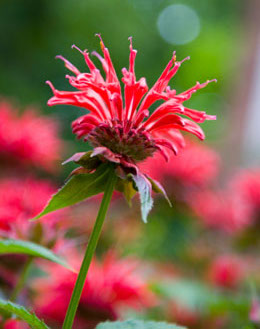A Bee Balm plant can be easily recognized by its unique appearance. Here are some facts about this pretty flower.

The Bee Balm plant, classified as
Monarda Didyma, is found in pink, red, and white colors. They are known as herbaceous perennials. Herbaceous plants are those which have non-woody stems. A "perennial" plant is a plant which survives the winter, even when its growth above the ground dies. The Bee Balm has petals shaped as spikes, which is what makes them uniquely beautiful. This plant belongs to the mint family and its blooms and leaves have a minty fragrance. Following are some of its major characteristics.
Characteristics
The Bee Balm plant is indigenous to eastern North America. It grows during early to late summer and attains a height of 2-4 feet. This plant requires adequate sunshine and grows well under a full sun. It requires moist and well-drained soil for growth. The leaves and flowers of the fresh as well as dried Bee Balm are used to make tea. Also, hummingbirds, butterflies, and bees are attracted to this plant because of its fragrance and nectar. The plant grows and spreads fast, so it requires lots of space to grow.
Growth
The Bee Balm should be planted in an area which has partial to full sunshine and good air circulation. It should ideally be planted in spring or fall and a space of at least 1 to 2 feet should be maintained between each plant, because it spreads very fast. A 12 to 15 inches deep hole should be dug to plant it. Mix some compost while planting it. Then place the plant in the hole, cover it lightly with soil, and water it enough to moisten the soil. Do not over water. Use the 10-10-10 garden fertilizers in small amounts to nourish the plant.
Care
It is important to provide the Bee Balm with plenty of space to grow and spread. Also, the plants have to be divided every few years, in the spring, in order to prevent them from forming an entangled mess. Apply a layer of compost each spring along with a 2 inch layer of mulch to retain moisture. In the fall, prune the plant down to an inch or two above the ground. Remember that it needs to be protected from powdery mildew. In case it succumbs to powdery mildew, trim the plant down till the ground surface. Deadheading can also be done to cause it to re-bloom. Deadheading means removing the spent flowers so as to promote fresh flowering.
Uses
Apart from their aesthetic value, the Bee Balm leaves and flowers are used to make tea. Bee Balms which have red blossoms are commonly known as Oswega tea. The fragrant oil of the Bee Balm is used to treat skin eruptions, rashes, and infections. It can also be used for relief from fever, nausea, headaches, and sore throat. Also, its pulverized leaves are used to treat bee sting wounds. That's why the name for this plant.
We can see that this flower is truly multi-faceted. It is one of the few plants which can be grown as herbs, has an aesthetic appeal, and is easy to grow and maintain. All those who love flowering plants must have a Bee Balm plant in their gardens; being a perennially growing plant, it will continue to add to the beauty of your garden for a long time.






 The Bee Balm plant, classified as Monarda Didyma, is found in pink, red, and white colors. They are known as herbaceous perennials. Herbaceous plants are those which have non-woody stems. A "perennial" plant is a plant which survives the winter, even when its growth above the ground dies. The Bee Balm has petals shaped as spikes, which is what makes them uniquely beautiful. This plant belongs to the mint family and its blooms and leaves have a minty fragrance. Following are some of its major characteristics.
The Bee Balm plant, classified as Monarda Didyma, is found in pink, red, and white colors. They are known as herbaceous perennials. Herbaceous plants are those which have non-woody stems. A "perennial" plant is a plant which survives the winter, even when its growth above the ground dies. The Bee Balm has petals shaped as spikes, which is what makes them uniquely beautiful. This plant belongs to the mint family and its blooms and leaves have a minty fragrance. Following are some of its major characteristics.